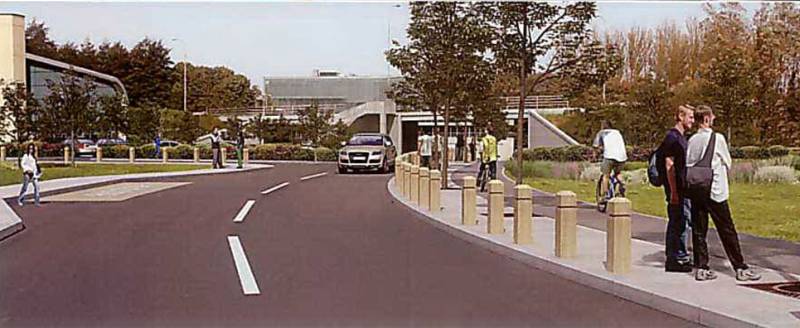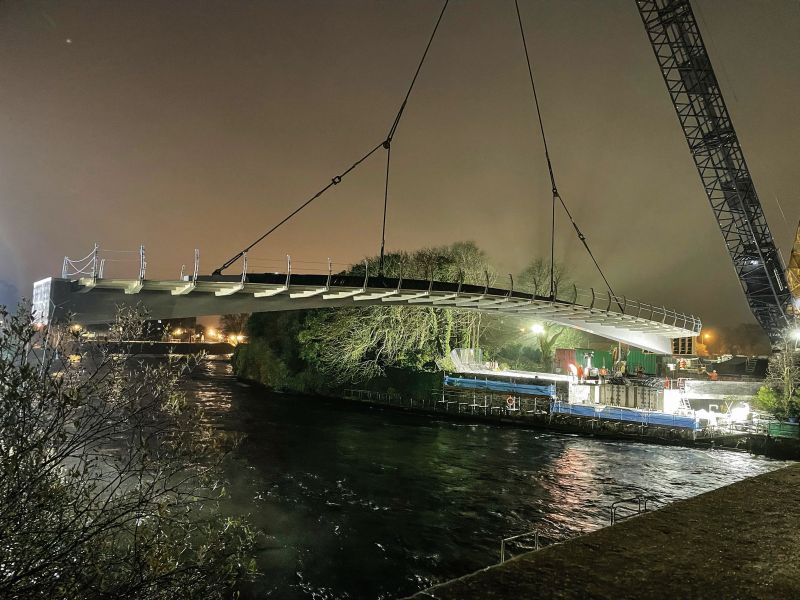CITY TRIBUNE
Quincentenary Bridge underpass plan involves lanes ‘stilts’

Authorities at NUI Galway have resurrected plans to build a major underpass of the Quincentenary Bridge – which is likely to involve the construction of temporary lanes on ‘stilts’ for the N6.
The university was granted planning permission in 2013 for the project – to the south of the existing underpass – but it was ‘mothballed’ due to the economic downturn and the route selection process for the N6 Galway City Ring Road (outer bypass).
Now, the €1 million underpass project – 15 metres wide including cycle lanes and footpaths – has been put back on the agenda, with NUIG requesting an extension of time on planning permission for a further five years.
Unless otherwise specified by the Council, a grant of permission expires after five years – the underpass grant will expire in May 2018, unless the local authority grants the further five-year period requested.
The existing underpass which was built in the 1980s is considered totally inadequate to serve the needs of the college or its 20,000-student population.
The new underpass will be located 140 metres south of the existing one – to provide new pedestrian, cyclist and vehicular (including HGVs) links between the north and south campus and will involve the relocation of part of the existing roadway.
The plans include the realignment of the approach road and path under the bridge and a riverside walkway which will become part of the proposed ‘Greenway’ project, eventually linking the playing fields at Dangan with Fisheries Field.
In the application to planners for more time, NUIG said: “Commencement of the works has been prevented due to uncertainty regarding the route selection of the N6 Galway City Ring Road. The on-line route option involved the re-use and enhancement of the existing Quincentenary Bridge.
“This option has since been discounted and the new N6 road project is programmed to be lodged with An Bord Pleanála in the short-term.
“Funding for the project could not be sourced during the duration of the permission due to the prevailing economic conditions and associated lending restrictions. Since the beginning of the recession, government funding for Ireland’s third-level sector has been cut a considerable amount.
“However, having regard to reducing construction costs, and the ‘bottoming out’ of the economic recession, [NUIG] is confident that the proposed new underpass will be constructed in the coming years.”
The carriageway will be 15 metres wide – with a 7m road, two 2m cycle tracks and two 2m footpaths – and will have 5.3m of headroom to accommodate HGVs.
The bridge superstructure alone will take six months to build in three phases so that four lanes for vehicular traffic are maintained at all times:
■ Construction of a temporary footway/cycleway on the northern side of the N6, and close the southern side. The four traffic lanes would then move north, allowing the southern one-third side of the underpass bridge superstructure to be built and finished.
■ Divert the two westbound traffic lanes of the N6 southward onto the Phase 1 part of the underpass bridge. This would allow the middle one-third part of the new bridge superstructure to be built.
■ Construct temporary footway/cycleway on the southern side of the N6. Move the two eastbound lanes of the N6 onto the Phase 2 part of the underpass bridge, which would allow the final third (northern) of the superstructure to be built.
Now, the four lanes of the N6 would be moved back to their final positions, and the embankment beneath the new bridge could be excavated.
When the project goes to tender, a full Traffic Management Plan will have to be drawn up, which is likely to include the suggestion that the new temporary lanes for the N6 be built on ‘stilts’.
In the original grant of permission, planners ordered that lane closures on the Quincentenary Bridge must be aboided and the contractors should consider working at night.
A contract must also be drawn up between the Council and NUIG (and approved by Transport Infrastructure Ireland) which states that the college will finance the entire project, and ensure risks of delays are minimised.
A decision on the extension of time application is due in mid-August, and if approved, the university would have to complete the project by August 2023.
CITY TRIBUNE
Galway ‘masterplan’ needed to tackle housing and transport crises

From the Galway City Tribune – An impassioned plea for a ‘masterplan’ that would guide Galway City into the future has been made in the Dáil. Galway West TD Catherine Connolly stated this week that there needed to be an all-inclusive approach with “vision and leadership” in order to build a sustainable city.
Deputy Connolly spoke at length at the crisis surrounding traffic and housing in Galway city and said that not all of the blame could be laid at the door of the local authority.
She said that her preference would be the provision of light rail as the main form of public transport, but that this would have to be driven by the government.
“I sat on the local council for 17 years and despaired at all of the solutions going down one road, metaphorically and literally. In 2005 we put Park & Ride into the development plan, but that has not been rolled out. A 2016 transport strategy was outdated at the time and still has not been updated.
“Due to the housing crisis in the city, a task force was set up in 2019. Not a single report or analysis has been published on the cause of the crisis,” added Deputy Connolly.
She then referred to a report from the Land Development Agency (LDA) that identified lands suitable for the provision of housing. But she said that two-thirds of these had significant problems and a large portion was in Merlin Park University Hospital which, she said, would never have housing built on it.
In response, Minister Simon Harris spoke of the continuing job investment in the city and also in higher education, which is his portfolio.
But turning his attention to traffic congestion, he accepted that there were “real issues” when it came to transport, mobility and accessibility around Galway.
“We share the view that we need a Park & Ride facility and I understand there are also Bus Connects plans.
“I also suggest that the City Council reflect on her comments. I am proud to be in a Government that is providing unparalleled levels of investment to local authorities and unparalleled opportunities for local authorities to draw down,” he said.
Then Minister Harris referred to the controversial Galway City Outer Ring Road which he said was “struck down by An Bord Pleanála”, despite a lot of energy having been put into that project.
However, Deputy Connolly picked up on this and pointed out that An Bord Pleanála did not say ‘No’ to the ring road.
“The High Court said ‘No’ to the ring road because An Bord Pleanála acknowledged it failed utterly to consider climate change and our climate change obligations.
“That tells us something about An Bord Pleanála and the management that submitted such a plan.”
In the end, Minister Harris agreed that there needed to be a masterplan for Galway City.
“I suggest it is for the local authority to come up with a vision and then work with the Government to try to fund and implement that.”
CITY TRIBUNE
Official opening of Galway’s new pedestrian and cycle bridge

The new Salmon Weir pedestrian and cycle bridge will be officially opened to the public next Friday, May 26.
Work on the €10 million bridge got underway in April 2022, before the main structure was hoisted into place in early December.
A lunchtime tape-cutting ceremony will take place on Friday, as the first pedestrians and cyclists traverse the as-yet-unnamed bridge.
The Chief Executive of Galway City Council, Brendan McGrath, previously said the bridge, once opened, would remove existing conflicts between pedestrians, cyclists and traffic “as well as facilitating the Cross-City Link public transport corridor over the existing 200-year-old bridge”.
The naming of the new bridge has been under discussion by the Council’s Civic Commemorations Committee since late last year.
One name that has been in the mix for some time is that of the first woman in Europe to graduate with an engineering degree – Alice Perry.
Ms Perry, who was from Wellpark, graduated from Queen’s College Galway (now University of Galway) in 1906. The university’s engineering building is named in her honour.
The bridge was built by Jons Civil Engineering firm in County Meath and was assembled off-site before being transported to Galway. Funding for the project was provided in full by the National Transport Authority and the European Regional Development Fund.
(Photo: Sheila Gallagher captured the city’s new pedestrian footbridge being raised on the south side of the Salmon Weir Bridge in December. It will officially open next Friday, May 26).
CITY TRIBUNE
Minister branded ‘a disgrace’ for reversing land rezoning in Galway City

From the Galway City Tribune – Minister of State for Local Government and Planning, Kieran O’Donnell was labelled a “disgrace” for overturning councillors’ decisions to rezone land in the new City Development Plan.
Minister O’Donnell (pictured) confirmed in a letter to Council Chief Executive Brendan McGrath last week that he was reversing 25 material alternations made by councillors to the CDP 2023-29. He made the decision on the advice of Office of Planning Regulator (OPR).
Minister O’Donnell directed that 14 land parcels that were subject to land-use zoning changes by councillors as part of the Material Alterations to the Draft CDP should be reversed.
He directed that a further 11 land parcels in the city should become “unzoned”.
The Minister found that the CDP had not been made in a manner consistent with recommendations of the OPR, which required specific changes to the plan to ensure consistency with the national planning laws and guidelines.
At last week’s Council meeting Cllr Eddie Hoare (FG) asked for clarity on the process by which councillors could rezone the lands that had been changed by the Minister’s direction.
Cllr Declan McDonnell said, “What he [Minister O’Donnell] has done is an absolute disgrace”.
And he asked: “Do we have to have another development plan meeting to deal with it?”
Both Cllrs Hoare and McDonnell wondered what would become of the lands that were rezoned or unzoned by the ministerial direction.
Mr McGrath said the Council had put forward an argument in favour of retaining the material alterations in the plan, but ultimately the Minister sided with OPR.
He said if councillors want to make alterations to the new plan, they could go through the process of making a material alteration but this was lengthy.
The Save Roscam Peninsula campaign welcomed the Minister’s decision.
In a statement to the Galway City Tribune, it said the direction would mean the Roscam village area on the Roscam Peninsula will be unzoned and a number of land parcels would revert back to agriculture/high amenity.
A spokesperson for the campaign said: “the material alterations made by city councillors following lobbying by developers continued the long-standing practice of councillors facilitating a developer-led plan rather than an evidence- and policy-based plan that meets the needs of the city.
“The Minister’s direction is an important step in restoring confidence in the planning system. It is clear from the City Council’s own evidence on future housing projections that there was no requirement to zone these lands for residential purposes in order to meet the needs of the targeted population increase up to 2029,” the spokesperson added.















